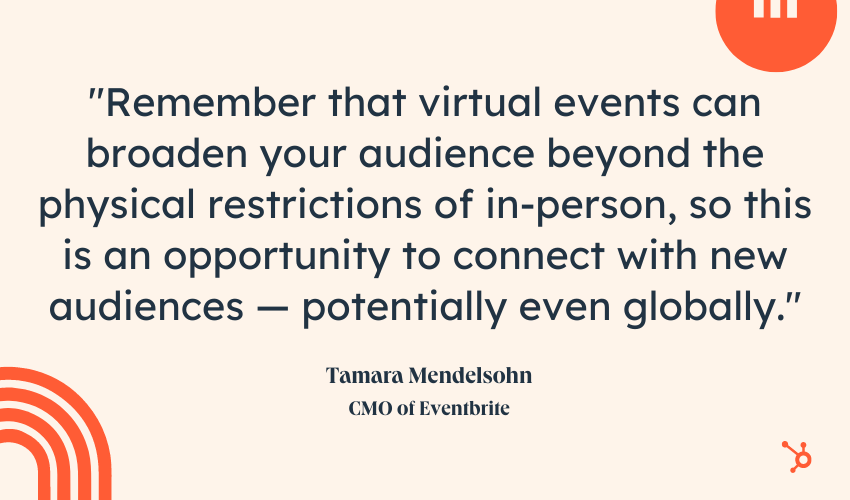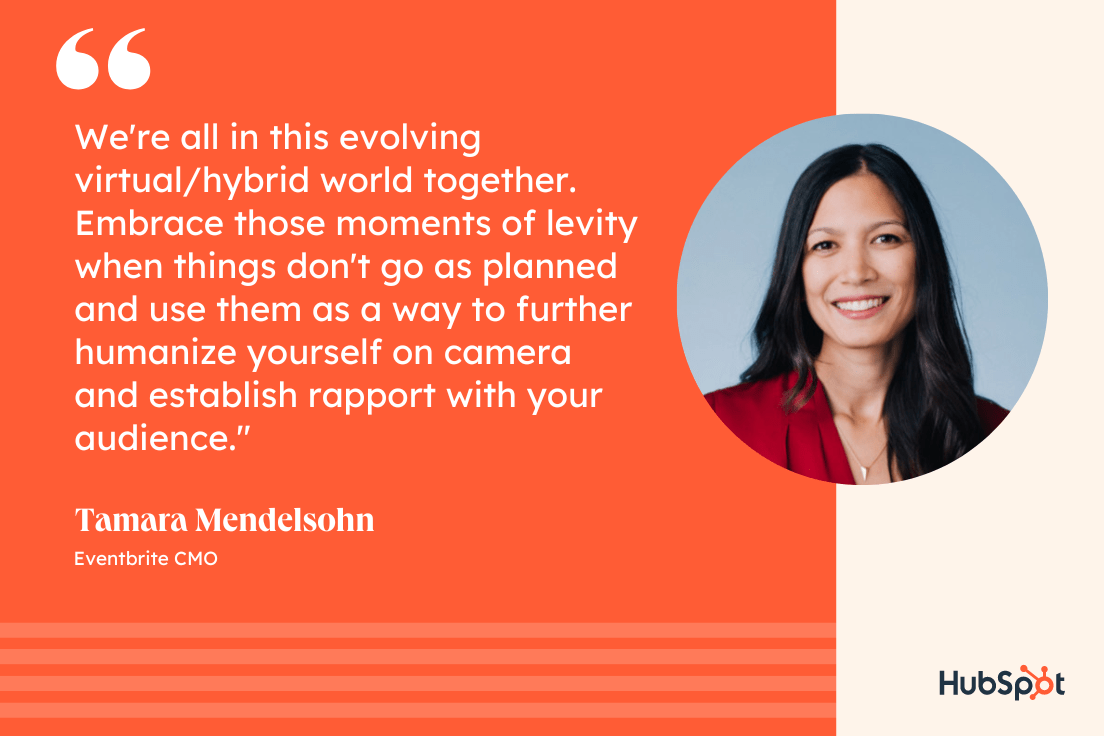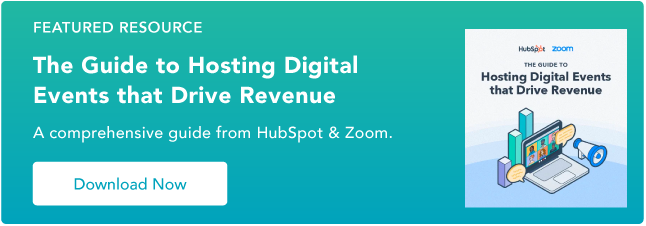As a result of the pandemic, there’s been a shift in recent years to virtual conferences.
But a virtual conference strategy can’t be a copy-and-paste of a physical one. Virtual conferences come with unique challenges, and require a new perspective to succeed.
Here, let’s explore the benefits of virtual conferences, take a look at some examples of successful virtual conferences to inspire you, and check out a few tools that can help you plan your own.
Plus, hear from Tamara Mendelsohn, CMO of Eventbrite, on her best practices for hosting a successful virtual event in 2023 and beyond.
Skip ahead:
- Virtual Conference Benefits
- 6 Virtual Event Best Practices, According to Eventbrite’s CMO
- Virtual Conferencing Tools
- Examples of Virtual Conferences
Virtual Conference Benefits
There are plenty of major benefits to hosting a virtual conference.
For one, it can lower the price of admission, enabling smaller businesses with limited budgets to purchase tickets to your conference and offer their own unique insights.
It also lowers the cost your business would have to pay for conference space, on-hand staff, catering, security, and much more.
Additionally, it allows people from across the globe to interact with each other without needing to spend exorbitant amounts on flights and hotels. Imagine how much easier it is for marketers from India, Ireland, Australia, and the U.S. to collaborate virtually, rather than trying to gather in-person.
It also may help you attract high-demand speakers who don’t have the time to commit to an in-person conference, but are happy to share industry takeaways via a quick video call or pre-recorded presentation.
Additionally, an online conference enables you to create a product — recordings from your conference — that you can continue to share and use as a lead generation tool for months and years after the initial live launch.
And, finally, there’s the obvious: sometimes unforeseen circumstances, like a global pandemic, can make in-person conferences in certain locations simply impossible.
Emily Raleigh, HubSpot’s Marketing Manager of Brand and Strategic Partnerships, provides some advice if you suddenly find yourself shifting your in-person event to a virtual one: “If you are shifting from a live event, try to add extra value to the viewers who are now tuning in online. Do an extra session. Offer more Q&A time. Give an extra special offer. Find creative ways to add extra delight moments.”
Additionally, Raleigh mentions, “Virtual events can easily lose one of the best benefits of live events: human connection. To mitigate that, keep the event engaging and get the audience involved.”
Now that we’ve explored a few benefits, let’s dive into Mendelsohn’s tips for making your next virtual event a success.
6 Virtual Event Best Practices, According to Eventbrite’s CMO
1. Identify your audience.
As you sit down with your team to organize a virtual event, you first need to decide who the event is for — also known as your target audience. Your target audience will impact almost every aspect of your event, such as the speakers you select, the topics you cover, and even the time you host the event.
Mendelsohn told me, “Dig into who you want to attend your event, and understand their challenges and goals. What’s going to inspire them to register? What value are you providing? How can you best deliver on that in a virtual environment?”
She adds, “Remember that virtual events can broaden your audience beyond the physical restrictions of in-person, so this is an opportunity to connect with new audiences — potentially even globally.”
This is one of the major benefits of virtual events: The opportunity to reach a wider audience than you otherwise could. Of course, when defining your target audience, you’ll want to consider which regions make the most sense for your event.
For instance, is your topic broad enough to be global, or is it better to host one session for your North American participants, and another for specific regions in South America or Europe? Alternatively, perhaps it’s better to start with a small group in one city, and expand from there.
2. Craft your event strategy.
During the global pandemic, many marketers rushed to repackage in-person events into virtual ones. But in reality, virtual events require a completely different strategy. After all, the medium is different, the technology is different, and the way attendees interact is — you guessed it — different.
A well-rounded strategy should outline your goals, budget, and action plan for the big day, according to Mendelsohn.
A good place to start is answering the “why”, or purpose of your event. On the business side, what do you hope to achieve? For example, maybe you want to build brand awareness, drive revenue, or grow memberships. It’s also important to consider what your attendees want from your event. This could be networking, education, entertainment, or a mix of all three.
Mendelsohn gave an example of one of Eventbrite’s creators, custom glass studio UrbanGlass, which hosted an instructor-led training on crafting glass. After attendance was lower than expected, they revisited their strategy to understand why. They realized attendees were seeking community and opportunities to work together.
By experimenting with their virtual group classes to ensure they offered a better sense of community and collaboration, UrbanGlass ultimately found much more success.
3. Make it easy for your audience to interact and network.
It’s already tough to get people engaged in person, but once you shift the event online, you have to compete against unwanted distractions.
That said, you don’t have to settle for low engagement. In fact, 47% of people are more likely to ask a question at a virtual event, and 37% are more likely to speak to someone in a virtual booth than a real one. The key is finding opportunities for people to interact.
“Build in opportunities for audience participation. This could be a poll or pulse check at the start of an event, a brainstorm in the middle, or a Q&A session at the end,” Mendelsohn told me.
She continues, “If it’s appropriate for your event, send participants into breakout rooms. People are more likely to participate in smaller groups.”
If your event has a physical component — such as a yoga session or cooking class — it’ll be easier to engage the audience. But if there isn’t, Mendelsohn recommends thinking outside the box: “Encouraging your audience to get up, move around, or participate in a group activity can be really fun and powerful.”
4. Promote your event before, during, and after.
Whether your event is in-person or virtual, you still need attendees — and that means event promotion. According to Mendelsohn, this should happen before, during, and after your event.
She says, “This could entail paid or partner promotion, live social media posts during the event, and ‘thank you’ emails after. Make sure to tap into your network and ask others to spread the word.”
Event branding is another important aspect of promotion. This can be anything from your logo and tagline, to your website and promotional materials. For Mendelsohn, it’s all about creating strong branding and keeping it consistent across your program.
5. Schedule tech rehearsals.
Virtual events rely on technology — but technology isn’t always reliable. This is why Mendelsohn recommends tech rehearsals.
She advises, “Host practice sessions with your speakers and crew — and have a fallback plan in case the unexpected happens.”
Another mistake with technology is assuming your attendees are all tech-savvy. In reality, people have varying comfort levels when it comes to technology.
Mendelsohn underlines this point: “For people who don’t frequent online events, even finding the Zoom link or knowing to enter a passcode can be tricky.”
To combat this challenge, consider conducting a test run of the event from the attendee’s perspective. Click on any links, send a message in the chat, and launch different sessions.
Additionally, you might test out using various platforms to increase accessibility based on people’s platform preferences.
For instance, Mendelsohn told me, “One of Eventbrite’s creators, Eastwind Books of Berkeley, saw this challenge when they introduced virtual programming. Their solution? Streaming on multiple platforms, such as Facebook Live, and then archiving events on YouTube, so people could attend via their preferred technology and revisit later.”
6. Show humility, and have fun with the process.
Finally — have fun, and be willing to show humility if something doesn’t go as planned.
Mendelsohn says, “At our RECONVENE summit last year, the Lincoln Park Zoo’s Victoria Luisi said something that’s stuck with me: ‘Virtual is now our playground to try things we would have never been able to try before.’ This approach can expand our thinking about virtual events as a whole, and it’s especially instructive for engaging virtual audiences.”
She adds, “We’re all in this evolving virtual/hybrid world together. Embrace those moments of levity when things don’t go as planned and use them as a way to further humanize yourself on camera and establish rapport with your audience.”
Now that we’ve explored a few best practices, let’s dive into tools that can help you create your own virtual conference.
Virtual Conferencing Tools
1. Hopin
Hopin is an all-in-one platform for planning online conferences, offering everything from a virtual reception to breakout sessions, a mainstage, and networking events.
The networking tool is particularly helpful, with a timer you can set for each attendee to mingle with another for just a couple minutes before moving onto the next conversation (and, if the conversation goes exceptionally well, they can click “Connect” to receive contact information of the other attendee to follow-up later).
Your event can include both webinars and live-streams, and a Live Chat function enables attendees to ask questions in real-time. Additionally, attendees can use virtual booths to promote their products or services, and offer discounts as well.
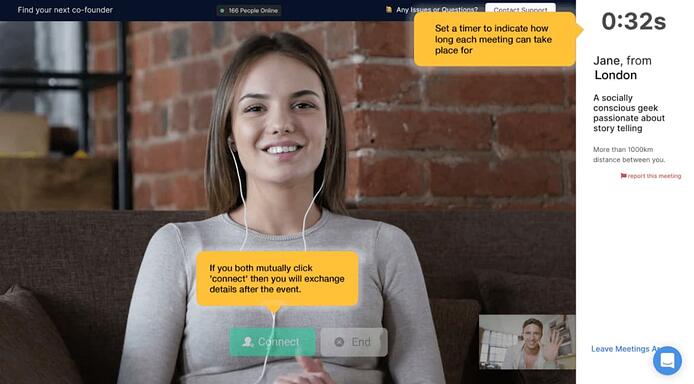
2. Whova
The Whova Event App has been a leader in attendee engagement and networking since 2014. For four years in a row, Whova has received both the Best Event App award and the People’s Choice Award from the Event Technology Awards.
Event organizers can use Whova to help make online events highly interactive, fun, and productive before, during, and after the event. The tool directly integrates with live streaming and video hosting tools such as Zoom, Google Hangout, YouTube, Vimeo, etc. It also provides live Q&A, attendee networking, a discussion board, meeting-matches, a virtual exhibitor hall, and even virtual meet-ups.
Many organizers provide access to the Whova app prior to their events to let attendees virtually socialize and discuss various topics, one-on-one or in virtual groups, making everyone feel more connected by the time the event comes around. Every attendee has a professional profile, allowing them to find others with whom they have common interests. The ice breaker and in-app chat, in particular, make it fun for strangers to get to know one another on a personal level and communicate with both new and old friends.
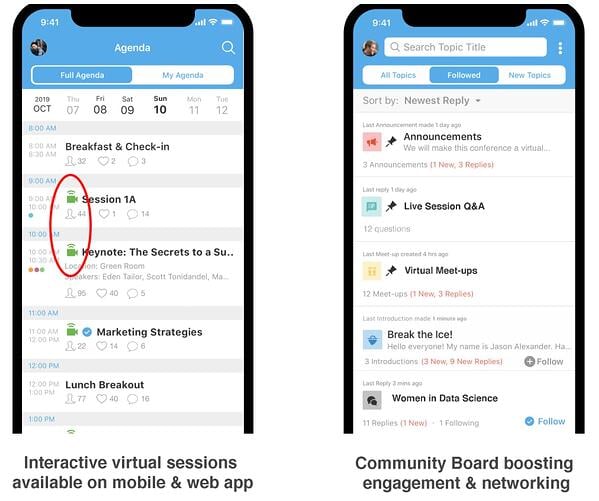
3. Accelevents
Accelevents is a customizable and flexible event platform for running virtual, hybrid, and in-person conferences. It is a robust platform offering powerful registration, true white labeling, integrated live streaming, in-depth analytics, and numerous exhibitor and sponsor opportunities. Although the platform is intuitive, they still take support seriously with an average response time of fewer than 30 seconds.
They are known for their suite of networking tools which provide powerful attendee engagement. Among the networking tools are lounges, workshops, 1:1 attendee video, automated speed networking, and live attendee chat.
In addition, exhibitors and sponsors have the ability to customize their own booth and engage in video chat with their prospects that visit their booth. The build-in gamification and push notification tools are a great way to drive further engagement throughout the event. They can also advertise on banners displayed throughout the platform and have easy access to lead management and insightful exhibitor analytics.
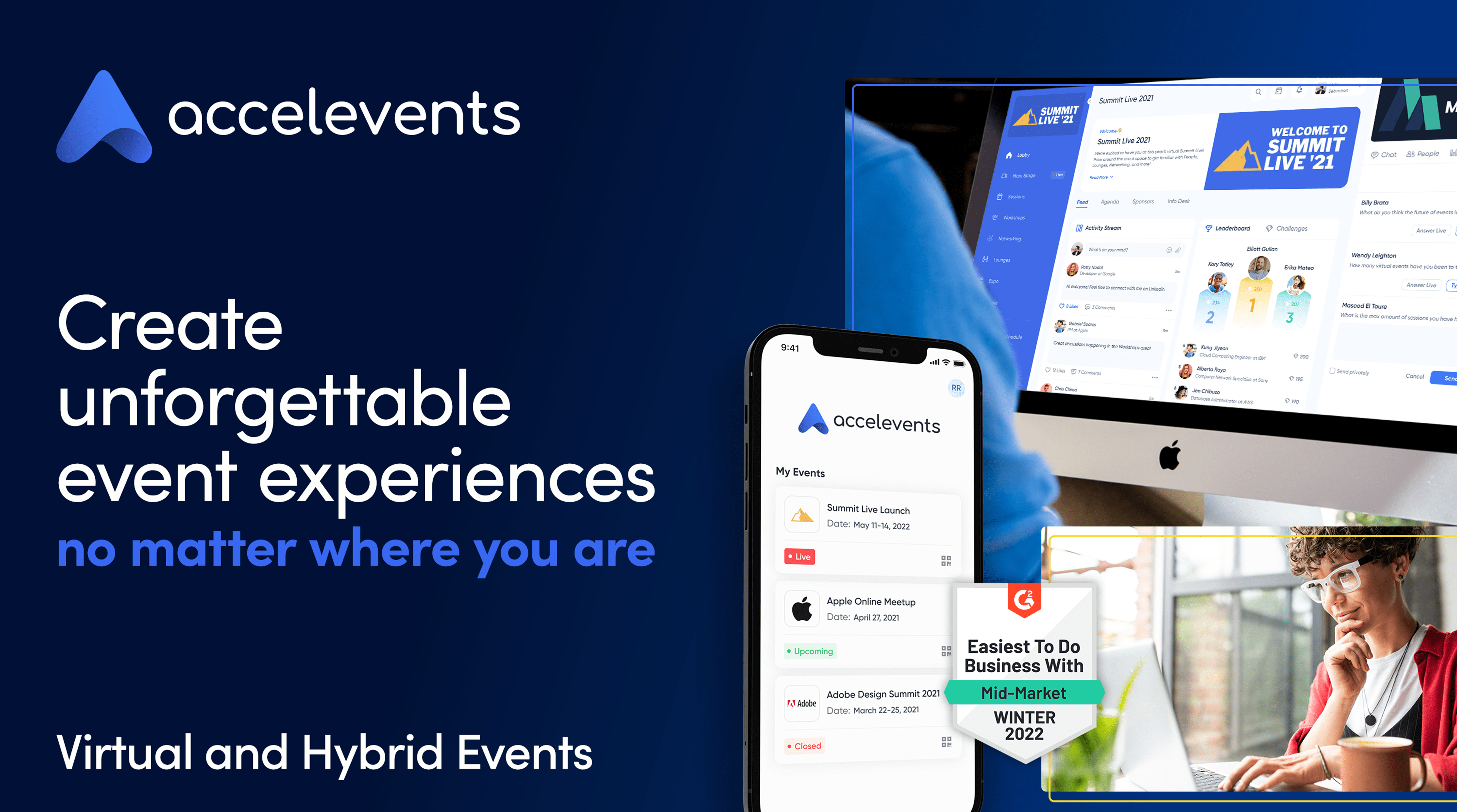
Examples of Virtual Conferences
Game Developers Conference
The 2022 Game Developers Conference (GDC) switched its in-person conferences to streaming recorded versions on the GDC Twitch channel. The conference will still have ceremonies for The Independent Games Festival (IGF) and Game Developers Choice Awards (GDCA), and will stream session content starting 9 AM PT daily, March 16-20.
The GDC has a well-organized itinerary posted on their website, with breakout sessions led by influencers and experts in the Gaming industry.
Additionally, you’re able to pause Live sessions if you’re interested in watching at a later time, and the GDC has included “Recommended Channels” with headcounts on the left side of the screen. With some sessions evoking over 30,000 viewers, it’s safe to say the GDC has successfully launched a virtual version of their initially in-person event.
2. HubSpot’s Partner Day
On April 7-8, 2020, HubSpot launched its own virtual Partner Day. The Partner team used Zoom, a popular video conferencing tool, and sent each presenter a “video kit” with a mic, camera, lighting, and backdrop, so that participants could experience an optimal viewing experience from each of the day’s virtual speakers. Additionally, attendees used Zoom to network with other partners.
I spoke with Arden Brust, a Manager on HubSpot’s Partner Marketing team, to learn about some challenges you might experience when planning a virtual experience of your own.
Brust told me: “When planning an online event, it’s critical you remain flexible and open-minded. With a virtual event, you run the risk of technology issues, as well as scheduling issues you might not have considered if you had everyone in-person (including timezone issues). To combat this, continue to iterate with your team and plan on pivoting — don’t get too attached to plan A that you don’t consider how plan B might work out better.”
3. How I Built This, by Women In Product
With the help of the Run The World virtual conferencing tool, the non-profit organization Women In Product launched an entirely virtual event March 7-8, 2020. The Women In Product conference included participants from China, India, Canada, and Silicon Valley.
The conference featured 10 speakers who’ve built successful products — including the Director of Product at GoDaddy, a PayPal Product Lead, and a Senior Product Manager at Ebay. The virtual event included fireside chats, keynote speakers, and networking events that enabled women to hear about the challenges and successes of product launches in different markets.
4. Webinar Mastery Summit
Jon Schumacher had hosted webinars online for a while with minimal results when he launched the Webinar Mastery Summit, a virtual conference for people who wanted to advance their webinar skills.
His first virtual summit featured 25 experts, and generated 7,000 new email subscribers and over $55,000 in revenue with his All-Access Pass sales. With All-Access, his participants receive lifetime access to 17 expert video sessions, full MP3 recordings of all sessions, three months of course creation software, and access to a private community for additional networking.
Ultimately, with virtual conferences, you’re able to create recorded packaged content for future lead generation and sales even after the initial live launch — something in-person conferences, for all its networking benefits, is unable to do.
5. HubSpot User Groups (HUGs)
Meghann Keogh, a HubSpot Marketing Manager in charge of HubSpot User Groups and Events, has experienced circumstances in which she found it necessary to cancel in-person events and create virtual ones, instead. Keogh told me she’s hosted virtual HUGs events for San Francisco, NYC, Berlin, London, Helsinki, Paris, Bogota & Mexico City.
Additionally, she’s created virtual fireside chats, including an upcoming one with CEO & Co-Founder Brian Halligan & Christian Kinnear, VP of Sales & Managing Director EMEA.
When asked how to run a successful virtual event, Keogh told me — “Whether in-person or virtually, people are hungry to connect. The feedback we have received so far has been extremely positive. It’s not just cities that are connecting, it’s countries.”
“What’s made our virtual events a success so far? Our amazing speakers who inspire, educate, and innovate our HUG communities.”
Keogh adds, “We’re committed to bringing relevant content to our HUGs, whether that’s in-person or virtually. We want to make sure our communities still have that chance to engage with one another, and we’re devoted to making that happen.”
![]()


